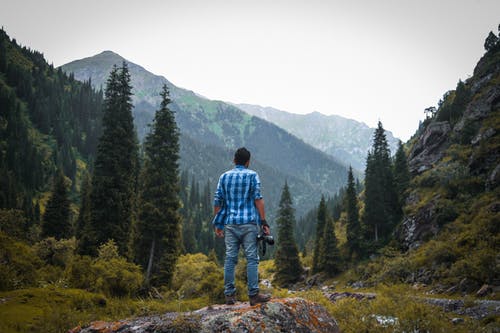Minimalist Art

Minimalist Art in Photography
Photographic minimalism is an artistic trend that is characterized by extreme simplicity. A challenge for photographers who must strive to find simplicity in any type of scene but trying to tell something with minimal elements. Because this, that there is an underlying story or theme, is what will make the photograph in question take the step from being a “pretty picture” to being a good picture.
Therefore, making minimalist photography is not easy. First, because it can be complicated to get used to achieving the necessary simplicity; second, because telling a story from an image with very basic elements is not an easy task.
Photography Minimalist
But what is minimalism? Well, if we resort to what the RAE says about it, we find two meanings: “Contemporary artistic current that plays with limited elements” and “Aesthetic and intellectual tendency that seeks the expression of the essential by eliminating the superfluous”.
As you can see, everything points to simplicity, the “less is more” and the use of limited elements in which we have to be able to extract all its expressiveness. Like all visual art, its foundations are found in the basic elements of the design (line, shape, color, texture, shape, composition …), but in this case using them in their purest and simplest form.
Therefore, these elements usually charge a weight that we do not find in another type of photography, often becoming the only protagonists. All this we will see below where we show you some of the keys to be able to enter the exciting field of minimalist photography.
Macro Photography
Why macro photography is the photographic equivalent of yoga or meditation
Surely the most decisive thing for a photograph to be minimalist is its composition, since through it we will take care of making what appears in the image comply with the simplicity rule. Of course, the idea is to include the essential, eliminate unnecessary things and help with basic elements that we will see later (lines, color, textures …) to compose a significant image.
This is why people tend to isolate objects (perhaps using a telephoto lens), since it is a possibility of achieving minimalist photos (even sometimes reaching macro photography), although of course you can also do minimalism using open (and large) planes angular), because simplicity can be found in any environment, whether natural or urban.

Minimalist Photography
On the other hand, and due precisely to simplicity, in minimalist photography it is quite advisable to use the rules of composition as the well-known rule of thirds, which in this type of images is usually very useful to direct the viewer’s attention to the main topic.
Finally, also consider the importance of negative space, that is, space that is theoretically empty and that in minimalist photography usually takes on a special meaning. In addition to serving so that the image “breathes”, this space interacts directly with the rest of the elements included in the photo and, therefore (and always taking into account the priority to simplify) must be in harmony for the composition to work.
Color is a quality that can become the best ally of the minimalist photographer. And it is that playing with the language and the wide possibilities offered by the different wavelengths of the electromagnetic spectrum is one of the most powerful resources to get an image to “speak” even if it has very few elements.
This one in particular brings expression, emotion, sensation, character and even symbolism. That is why simply through color you can express a lot, for example a specific quality by the use of a certain hue that moves to our image. As you know, warm colors are identified (among others) with qualities such as heat, joy and movement, while cold colors are often associated with cold, serenity and strength.
Of course you can also opt for the absence of color, and choose black and white, or a mixture of both. In fact, contrast is another fundamental element when we talk about color, since the contrast of very different shades establishes a dialogue that can provide much information to the image. So take advantage of its possibilities, do not be afraid to use the color and take advantage of it playing with the different shades, contrasting complementary colors or using similar tones; There are a thousand and one different possibilities.

Depth Photography
Its utility is very varied, from closing spaces to providing depth to photography, through the always important role they play in directing the viewer’s gaze.
Therefore, since in minimalist photography we seek maximum simplicity, when composing the image we must try to pay attention to the lines that appear to ensure that they lead to the right place.
The “external configuration of something”, according to the RAE, is another basic element in photographic minimalism. And it is that without a doubt few disciplines put so much value in the form of things like this, in which many times a single object becomes the absolute protagonist of the image.
Basic Elements of Photography
The elementary forms are the square, the circle and the triangle, each with its own qualities, but it is evident that these are basic elements that are juxtaposed in infinite combinations, both in the natural and urban environment, giving rise to compound forms much more complex and with its own qualities.
Thus, the organic forms are usually soft and are associated with a feeling of peace, naturalness and uniformity, while inorganic forms are usually acute and tend to provide activity and agitation in the photographs. All this must be taken into account when creating the image, opting for one or the other or being able to combine both aspects in a dynamic composition.
Patterns and texture
Another resource that is much appreciated in minimalist photography is the repetition of elements, what are called patterns, which are often associated with texture. The inclusion of these elements in the images is undoubtedly a good useful resource for any type of composition, but in this area it can take on even more value.
And is that minimalism, patterns and textures combine perfectly, and use them together has many possibilities. As regards the patterns, their use can serve both to emphasize the size and number of the elements and is very useful to accentuate the feeling of space.
Photography Harmony
For its part, the texture appeals directly to the sense of touch and, therefore, adds relief in some way to the image. Including it allows highlighting the object and helps achieve a sense of realism and three-dimensionality. In addition, depending on its shape, the texture can provide extra values to the image such as softness, roughness, purity, coarseness, violence …
To do this, by the way, you have to take into account another variable, lighting. Undoubtedly something very important for any image but in the case of textures it becomes essential to enhance its effect.
Another fundamental element that must be taken care of in minimalist photography, although in this case it is hardly the protagonist. In fact, as in the portraits here the most important thing is that the background does not divert attention from the most important, so it is recommended that they be completely smooth.
Of course, in the case of images based on the “less is more” it is also very important that what is seen in the background of the image is in perfect harmony with the rest and serves either to highlight or complement the subject or main element of the photo.
As we mentioned at the beginning, the basis of minimalist photography is to add simple elements, which is why we must also limit the theme that appears in the image and look for a simple and easy to understand message. Anything is likely to become the protagonist of the photo, so it is advisable to start with simple things, perhaps some common object that you have in your own home.
Something in boring theory can become striking if you are able to enhance the message it conveys, although of course you can always leave it to the imagination of the viewer himself. Let us not forget that minimalist photography can be perfectly framed as abstract art and therefore with a totally open meaning.
In short, anyone who intends to go into photographic minimalism will find themselves in an exciting environment, with their own and very particular characteristics, with a special prominence of some of the most basic elements and fundamentals of photography that we have reviewed. All this constitutes a challenge without a doubt stimulating for anyone who is willing to try to achieve stunning photos with the minimum possible.
